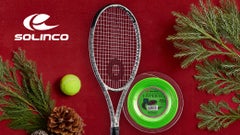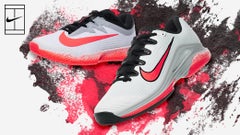Wilson Hyper ProStaff 6.5

The Hyper ProStaff 6.5 is a departure from the stereotypical ProStaff racquet. If ProStaff were an actual word in the dictionary, it would be defined as "a traditionally weighted and balanced racquet with an emphasis on control and measured power". While the 6.5's emphasis is definitely on control, it strays from this description because at 10.4 ounces it's decidedly lighter than any other ProStaff. The result of this lighter weight, combined with the 6.5's flex, balance, and string pattern make it the least powerful of all the ProStaff racquets. In fact, it may be the least powerful racquet on the market today.
The 6.5 makes up for its lack of power (at least partially) by being much more maneuverable than other player's racquets, including the other ProStaffs. This extra maneuverability makes it much easier to generate racquet head speed, catch up to hard hit balls, and pat yourself on the back for hitting such a good drop volley.
Does the Hyper ProStaff 6.5 "redefine" the ProStaff line? Like many of you, we were curious about how the 6.5 would suit Prostaff 6.1 and 6.0 players looking for enhanced maneuverability. Here's what we discovered.
Hyper ProStaff 6.5 Midplus
The ProStaff 6.5 Midplus is the first standard length, 95 square inch Wilson racquet (sold in the US) with an 18x20 string pattern (by comparison, the ProStaff 6.1 and 6.0 both have 16x18 string patterns). This tight string pattern reduces the power of the 6.5 Midplus and enhances the control. On a racquet that is already 2 points head light and weighs only 10.4 ounces, the tight string pattern guarantees that the only way you're going to generate power is by swinging hard. Fortunately, the weight and balance of the 6.5 Midplus make it easy to swing hard if you're so inclined.
From the baseline, the 6.5 mid plus is comfortable but the need for a fast swing is immediately noticeable. Drew says, "there's no question this is a 'big hitter's' racquet. There's almost no swing that's too big for this racquet. Of course you need to have the timing to pull that off." Mark adds, "it was actually kind of fun to swing as hard as I wanted and still keep the ball in the court. I usually don't swing that hard and I don't think I could do it for an extended period of time, but I see a lot of college team players who do, and I think many of those players would like the way this racquet plays."
One problem that occurs with most (if not all) racquets that are both light and light in the head is sweetspot shrinkage. Add a tight string pattern to the mix and you can end up with a very small sweetspot. Says Dan, "This frame requires faster swing speeds and larger swing types to create any kind of power or momentum. On center, it rides like a Porsche. Off center, you've got your VW van feel. The problem is, on center is about the size of a golf ball. It felt a bit like hitting with an 85 square inch head, not a 95. The dense string pattern didn't cater to mass topspin or underspin. Flat shots came off best and slice didn't have as much rotation as I like." Overall, the racquet's weight makes it less stable than any other ProStaff I've tested, and I've played with them all. There just isn't enough mass to support the small sweet spot and head light balance. That same weight, however, makes it a fast and easy swinging racquet." Granville agreed with Dan's assessment, "when you connect with the sweetspot it is very sweet, delivering good control with modest power. However, the sweetspot is quite small, making the frame sorely under-powered in match play, even for those players who typically generate power. The off-center hit is nearly powerless, often falling short or in the net. This was especially noticeable when deep in the court and on the run, where you'll need every bit of power you can muster just to keep the ball in play."
At net, the 6.5 midplus is quick and maneuverable but requires good mechanics and timing for best results. Dan comments, "short and sharp angled volleys found their mark due to the racquet's flex. You'll need to find the sweetspot to hit reasonably deep volleys; there is no consolation prize off-center." Granville offers, "the volley is my bread and butter shot. At this point in the playtest, the 6.5 midplus did as expected, moving through the air with ease, feeling good when striking the ball in the sweet spot, and yes, not providing the 'pop' necessary to end the point decisively." Mark adds, "you don't have to worry much about the ball flying long, so you can take a good poke at the ball. Shots hit outside of the sweetspot tended to fall short due to the drop in power." Don concludes, "the combination of the racquet's light weight, flex and dense string pattern resulted in my volleys dropping short more often than not. I quickly discovered my best shot at net was either a drop volley or short angle shot. Hitting deep volleys required too much swing to maintain control."
The 6.5 midplus performed as expected on overheads - lots of control, but little power. Says Dan, "No real surprises hitting overheads. A frame this flexible requires muscle and high swing speeds to help it along. For those used to heavier, head light models, timing may take some adjustment.. This racquet gets around quickly." Mark added, "Hitting overheads with the 6.5 midplus was more a matter of placement over power.. The racquet is easy to swing so I could get to most lobs, but it was difficult to get a lot of power if I couldn't get my weight into the shot. The control is very good with this racquet, so it was pretty easy to place the overheads in the corners."
Serving with the 6.5 midplus is fun because you can swing it so fast. However, the lack of weight in the head caused some problems on second serves. Mark explains, "I was pleasantly surprised at how well I served with the 6.5 midplus. I had good control, which I expected, but I was also able to generate quite a bit of power. If you have a slow, steady service motion you won't get much power out of it, but if you have a fast swing you'll be able to hit some hard serves. I did have trouble with kick serves. No matter how hard I tried, I couldn't swing fast enough to get a high kick. I could get the serves in, but I needed more racquet head speed than I could generate to make them effective." Dan, who can generate lots of racquet head speed on serves, adds, "crank the dial to 10 and let it rip - felt great on first serves. Once again though, I prefer more mass when serving for the very reason that second serves just don't have the necessary weight behind them to be effective. Swing speed is critical for an effective second serve delivery, specifically to get enough kick." Drew offers, "I could hit hard flat serves with good accuracy. Second serves can be hit with good spin but you'll need to keep the racquet speed up or your opponent will be able to attack them."
Granville found the 6.5 lacking on both first and second serves. His impressions on serving with the 6.5 midplus, "I could move it through the air with ease generating plenty of head speed. It has good control as a result of the maneuverability, but the issue with power, or lack of power, persists. While I felt I was hitting my serves well, they lacked the zip I am accustomed to with my heavier racquet in the same family (ProStaff 6.0 85)".
The 6.5 midplus is nimble on serve returns, approach shots and "miscellaneous" shots, but once again, power must be supplied by the user most of the time. Block returns can be effective against hard-hitting serve & volleyers. Drew comments, "not surprisingly, a full swing was no problem on returns. Hard serves could be blocked and kept low (assuming you get them over the net)." Dan recognized the touch shot potential of the 6.5 midplus, offering, "the flexibility of this frame lends itself well to feel and deft short angles when volleying. If you're a chip and charger or doubles specialist (with developed strokes) who camps at net and seeks touch and flex in a lighter, head light racquet, this racquet may have your name on it."
Not surprisingly, the Hyper ProStaff 6.5 Midplus will appeal most to big-hitting players seeking control in a lighter frame. The dense 18x20 string pattern will also provide relief for chronic string breakers. Despite the similar swing index rating, though, the 6.5 midplus isn't necessarily the best choice for current ProStaff 6.0 or 6.1 users, seeking a more maneuverable racquet. It is more restrained than either model, in terms of power and stability, as a result of it's light weight and flex. This can be addressed, though, by adding lead tape to the frame, something we feel will increase the racquet's appeal and overall performance.
Hyper ProStaff 6.5 Midplus Technical & Statistical Data
(Scores are determined by averaging individual play test scores)
|
|
||||||||||||||||||||||||||||||||||||
Hyper Pro Staff 6.5 Oversize
The 6.5 OS is, predictably, a broader appeal racquet than the midplus version. While not a powerhouse, it delivers adequate power for fast-swinging players. Granville offers, "it is the rare occasion that I prefer an oversize version of a frame to the midplus but that's the case with the 6.5. It's great for topspin players who like to "hit out" from anywhere on the court.
On groundstrokes, the larger head and almost 1/2 ounce of extra weight provide enhanced forgiveness when those fast swings are slightly off-target. Drew comments, "the larger head trampolines the ball more which means a more powerful sweetspot. Even though there's more power than the midplus, a big swing is still required." Dan adds, "a great racquet for players who can generate their own pace, are used to flexible, head-light frames but want better maneuverability and a larger hitting area. Spin production was outstanding - it was just as easy to hit high, loopy topspin shots to the backhand corner as it was low slice shots down the line." Mark continues, "I was able to slice the ball real well with this racquet.. A smooth high to low swing would result in a slice forehand or backhand with good spin and depth. On balls hit wide to my backhand, I was able to slice the ball back consistently deep even if I couldn't get my weight into the shot." Don finishes, "while still a bit underpowered for me, groundies felt more responsive and forgiving than the midplus, without that fly-away feel some oversize racquets have. The 18x20 string pattern fits better in the 110 head, allowing more spin potential. The 6.5 OS offers good comfort and maneuverability. Due to the lighter weight and flexible frame though, a solid swing is required for pace and depth."
Volleying with the 6.5 OS drew mostly praise from our playtesters. Dan liked it best, commenting, "finally, a lightweight, head-light ProStaff that's maneuverable, yet has some oomph at net - on and off-center. Maneuverability was outstanding - no trouble getting down for low volleys or getting the racquet in place for tough half-volleys. The large sweetspot was forgiving and off-center junk ended up with some kind of return. Overheads required some extra swing speed to put away. " Mark adds, "the 6.5 OS is solid at net. It's not a super powerful racquet, so you don't have to be timid when volleying. It also has a nice solid feel on off-center hits due to the larger head. On overheads, the oversize head was a bit cumbersome, requiring good preparation. Off-balance overheads don't have much power." Drew wasn't as impressed, saying, "volleying with the 6.5 OS is nothing special - it's better suited to baseline players."
On serves, the 6.5 OS' larger head allows for more spin, but generating racquet head speed requires some effort. Drew offers, "serving was somewhat arduous; a big swing is required for any sort of pace. A serving bright spot is the spin. With enough head speed, you can create really good kick." Mark concurs, adding, "I was able to hit good kick second serves consistently. Even when my swing slowed down, the racquet created enough power and spin to keep my kick serves deep and high."
On "other" shots, the 6.5 OS supplies the maneuverability to react quickly on serve returns, reaction volleys and off-balance groundstrokes. Again, power is relative to incoming ball speed, and more advanced players who hit against a harder ball will be better served than intermediate level players. The racquet's graphite/kevlar construction provides good damping for comfort, even during off-center shots.
The Hyper ProStaff 6.5 Oversize, like its midplus brother, is best suited for big-swinging players who want enhanced maneuverability in a larger head and conventional width beam. From top-spinning baseliners to aggressive all-court and serve/volley players, the Hyper ProStaff 6.5 provides control to those who supply the power. Drew describes both racquets best, saying, "if the midplus is a Jim Courier 'knock the felt off the ball' racquet, then the oversize is more of a Michael Chang 'whip the ball around the court' racquet.
Hyper ProStaff 6.5 Oversize Technical & Statistical Data
(Scores are determined by averaging individual play test scores)
|
|
||||||||||||||||||||||||||||||||||||
Playtester Profiles |
|
| Granville | 5.5 all-court player currently using a Wilson Pro Staff 6.0 85 |
| Dan | 5.5 all-court player currently using a Gamma Tradition 18 MP. |
| Mark | 5.5 serve & volleyer currently using a Prince Thunder Ultralite Titanium Oversize. |
| Don | 4.5-5.0 all-court player currently using a Pro Kennex Kinetic 5g Midplus. |
| Drew | 4.5-5.0 baseliner currently using a Wilson Pro Staff 6.0 85. |
Playtest racquets strung at mid-range with Tecnifibre NRG2 17 gauge strings.
Review date: April, 2000. If you found this review interesting or have further questions or comments please contact us.
All content copyright 2000 Tennis Warehouse.












